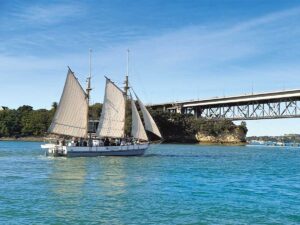Wellington Botanic Garden is a green haven in the bustling capital. Viv Haldane took time out to meander.
Wellington Botanic Garden has long been beloved by locals and visitors from afar. I recall it from my years as a student at nearby Victoria University, and I was delighted when my son Alex began talking fondly about ‘the Botanz’ in his first year at university. Many others have good memories of wandering through this peaceful setting, with its many winding paths and points of interest. The garden covers 25 hectares and is 150 years old. It is recognised as a Garden of National Significance by the Royal New Zealand Institute of Horticulture, and as an important Heritage Area by Heritage New Zealand.
 |
|
Anthurium lily
|
EXPLORING THE GARDENS
To the rasping sound of cicadas and the faint hum of the city beyond, we began our ramble. We decided to wander wherever it took our fancy, not knowing where we’d end up. We headed off down a gravelly path that led through native bush. Delicate ferns overhung the trail, where grasses and bracken also grew. A wood pigeon (kereru) flew out of nowhere and came to rest on a branch above our heads. We could make him out through the dense foliage as he decided on his next move.
The Waipiro Bushwalk, named after the stream that has its source in the hillside behind the Lady Norwood Rose Garden, is one of the few remaining areas of native forest. It’s so well preserved that you can imagine what the landscape was like many years ago, when hunters and gatherers used it as their food source.
Once out of the bush, we reached an area known as The Stables. These were named for the horses used in the gardens until 1945 to transport materials up and down the hills. The attractive, roughcast tiled buildings were built in the Arts and Crafts style, popular in Wellington at the time.
 |
|
The Seasonal Garden
|
PLANT COLLECTIONS
The gardens are a collection of plant species from all over the world. The layout reflects the careful curation that’s evolved over many years.
In the Seasonal Garden, beds are bursting with vibrant marigolds, parsley and purple salvia. What a brilliant combination.
 |
|
Vibrant water lillies
|
I went crazy with my camera in the Begonia House, taking photos of bright, exotic flowers such as lotus and tropical lilies, sumptuous begonias, orchids and Hippeastrum.
 |
|
The Begonia House
|
Lady Norwood Rose Garden was established in 1953. It has over 300 varieties of roses, planted in a formal layout.
In the Herb Garden there’s an inscribed quote from Benjamin Disraeli: “How fair is a garden amid the trials and passion of existence?” I can’t help but agree. Bees buzzed around fragrant herbs such as rose geranium and rosemary. White chamomile flowers spilled onto the brick path. From here, you have a bird’s-eye view of the rose garden and Henry Moore’s sculpture on the hill beyond.
The Succulent Garden is home to dry-loving plants such as aloes, agaves and cacti. Two of the gardeners were busily tidying an area nearby and filling fadges with green waste.
Other collections include camellias, hydrangeas, a rock garden, magnolias, ornamental grasses and Asian woodland plants and trees. There is also a children’s play area and Discovery Garden.
THE TREEHOUSE VISITOR CENTRE AND SHOP
You can either take the elevator or walk up the hill for another pretty view of the garden and the Soundshell. The shop has a range of New Zealand souvenirs and locally made gifts.
 |
|
A kinetic sculpture on Druid Hill
|
THE SCULPTURE TRAIL
We were keen to find the sculptures dotted throughout the gardens, all with plenty of information about them and their creators. ‘Rudderstone’ by Denis O’Connor is a black marble sculpture which reflects the bush surrounding it. Walking through the portal, which is in the shape of a rudder, you discover a reverse side of blue and white stripes.
Further along on Druid Hill is Andrew Drummond’s ‘Listening and Viewing Device’. This kinetic sculpture works on a gyroscope and moves in response to touch or wind.
Around the next corner we found Chris Booth’s ‘Peacemaker’, a group of stacked basalt boulders.
 |
|
Henry Moore’s ‘Bronze Form’
|
‘Bronze Form’, by world-renowned British sculptor Henry Moore, stands alone on a broad grassy slope along the Norwood Path. It’s the only Henry Moore sculpture in the country, presented to Wellington in 1988.
‘Body to Soul’ by Mary-Louise Browne is a stairway made of granite, with text-inscribed steps leading up the hill.
Regan Gentry’s ‘Green Islands’ are tall sculptures, made from number 8 wire and stainless steel, representing flax, cabbage tree, pohutukawa and toetoe.
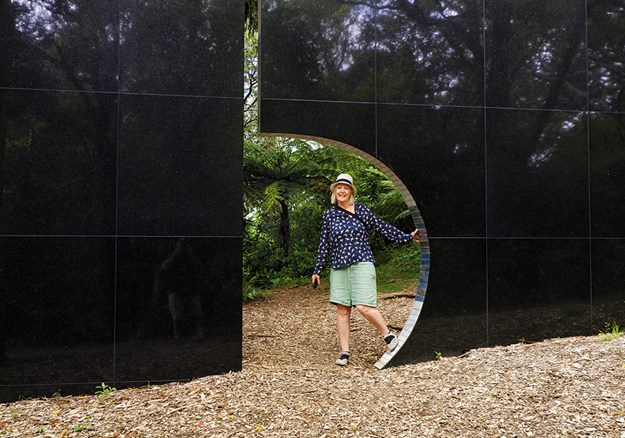 |
|
Viv Haldene checks out Dennis O’Connor’s ‘Rudderstone’
|
 |
|
‘Peacemaker’ by Chris Booth
|
PICNIC CAFE
After our walk, we felt in need of refreshment so it was good to stop and enjoy the delicious food on offer. Sitting in the arbour adjoining the rose garden was truly relaxing.
HISTORY
The area that is now the Botanic Garden was once a Maori settlement, with well-established pa at Pipitea and Kumoto. The land was densely forested with rimu, totara and matai. The people of Te Atiawa from Pipitea Pa used the plants for ngakinga (food cultivation), fibre and medicine, and caught the birds for food.
 |
|
‘South Pacific System’ by Jonathon Campbell
|
Te Atiawa, who also used large areas for trade, were displaced from their pa in the mid-1800s, despite promises that their land would be protected.
A move to acknowledge Maori heritage is underway, expanding the branding to ‘Wellington Botanic Garden ki Paekaka’, which means ‘at Paekaka’. The name has been gifted by mana whenua to apply to the Pukehinau area, and from the top of the cable car down to the Waipaekaka stream and Pakuao Kainga in Thorndon.
Wellington City Council is still formally considering this move.
The 25-hectare site was originally 5.26 hectares set aside in 1844 by the New Zealand Company. In 1868, the New Zealand Institute established the city’s botanic garden there, and a programme of planting began. James Hector, geologist, natural scientist, doctor, and the first manager of the park, was in charge of designing the layout. They formed paths, labelled plants, and levelled and laid out the Soundshell lawn as a teaching garden. The goal was to make the gardens not only for public enjoyment but a place to carry out scientific trials of overseas plants. This project became the seed bank for our future forestry industry.
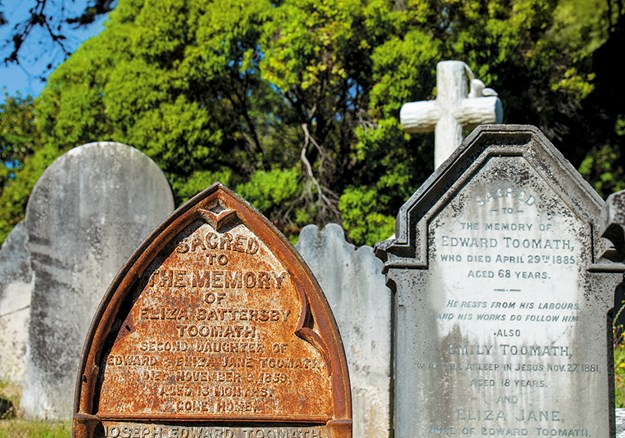 |
|
Bolton Street Cemetery is a memorial to Wellington’s early settlers
|
BOLTON STREET CEMETERY
This historic cemetery can be easily reached from the rose garden, past Andersen Park where joggers and touch rugby players were enjoying their daily workout. Along a path in the cemetery, office workers strolled in the sunlight, taking time out from their jobs in the city. We walked past angels and lichen-covered headstones, and rambling roses that grew rampantly across burial sites.
Some memorials are grand, with towering marble columns, while others are humble: a simple wooden cross nestled beneath some trees.
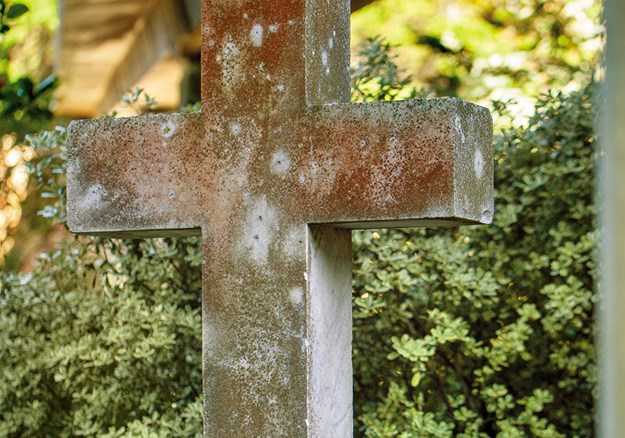 |
|
A lichen-covered cross rests beneeath the shadow of the motorway
|
I found this a fascinating place and visited twice, as there was so much to take in. The cemetery is divided in two and linked by a footbridge across the motorway – built in the late 1960s amid much controversy. The cemetery was closed for three years while 3700 burials were exhumed and reinterred in a vault under the lower cemetery lawn.
During this time, the Friends of Bolton Street Cemetery was formed and is still going strong. The society has done much work to inform the public of the cemetery’s significance, and remind us of the struggles faced by the growing colony.
In the lower part of the cemetery, the Anglican Mortuary Chapel is a replica of the chapel that was built in 1886. It contains a historical display and a register of burials.
In the lower cemetery a group of excited first-year university students were having their photos taken during orientation week. As I took yet another photo of a gravestone, it was a sharp contrast of past and present lives.
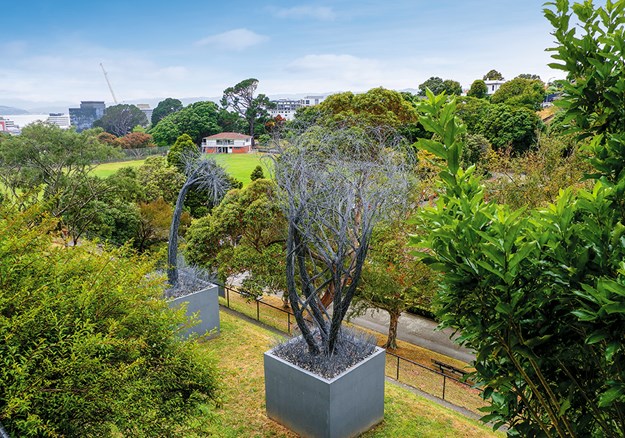 |
|
Regan Gentry’s sculptures, ‘Green Islands’
|
MORE INFORMATION
Find out more about the gardens at wellingtongardens.nz
Wellington Botanic Garden is at 101 Glenmore Street, Wellington.
HOW TO GET THERE
- Cable car: From the Cable Car Lane off Lambton Quay. It departs every 10 minutes.
- No 3 Karori bus: From Lambton Quay, it stops outside the Founders’ Entrance.
- Walking: A popular route is from The Terrace through Bolton Street Memorial Park.
- Car: The only public carpark in the botanic garden is next to the Lady Norwood Rose Garden. Access is through the Centennial Entrance. Parking is also available along Glenmore Street.
Parking for motorhomes in Wellington:
- Cuba Street motorhome park: cubastreetmotorhomepark.co.nz
- Capital Gateway Motorhome Park: capitalgateway.co.nz
- Camp Wellington: campwellington.co.nz



